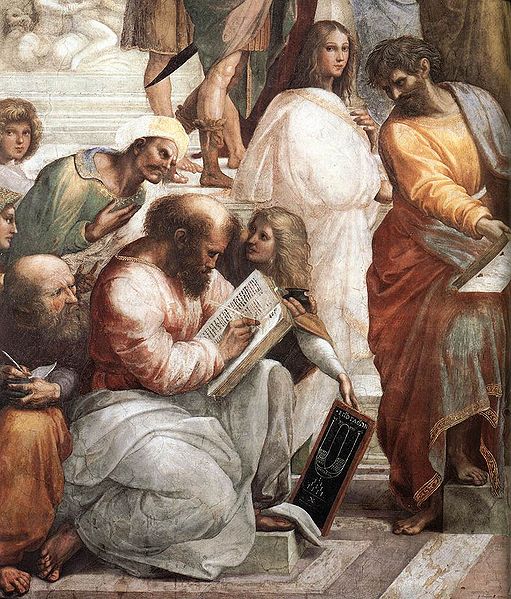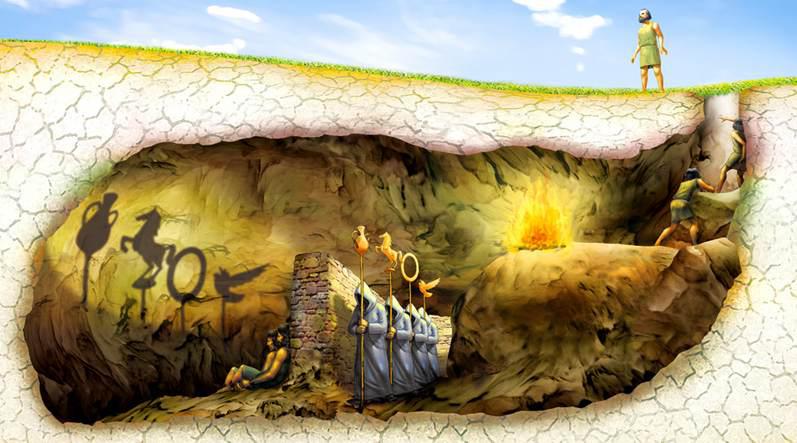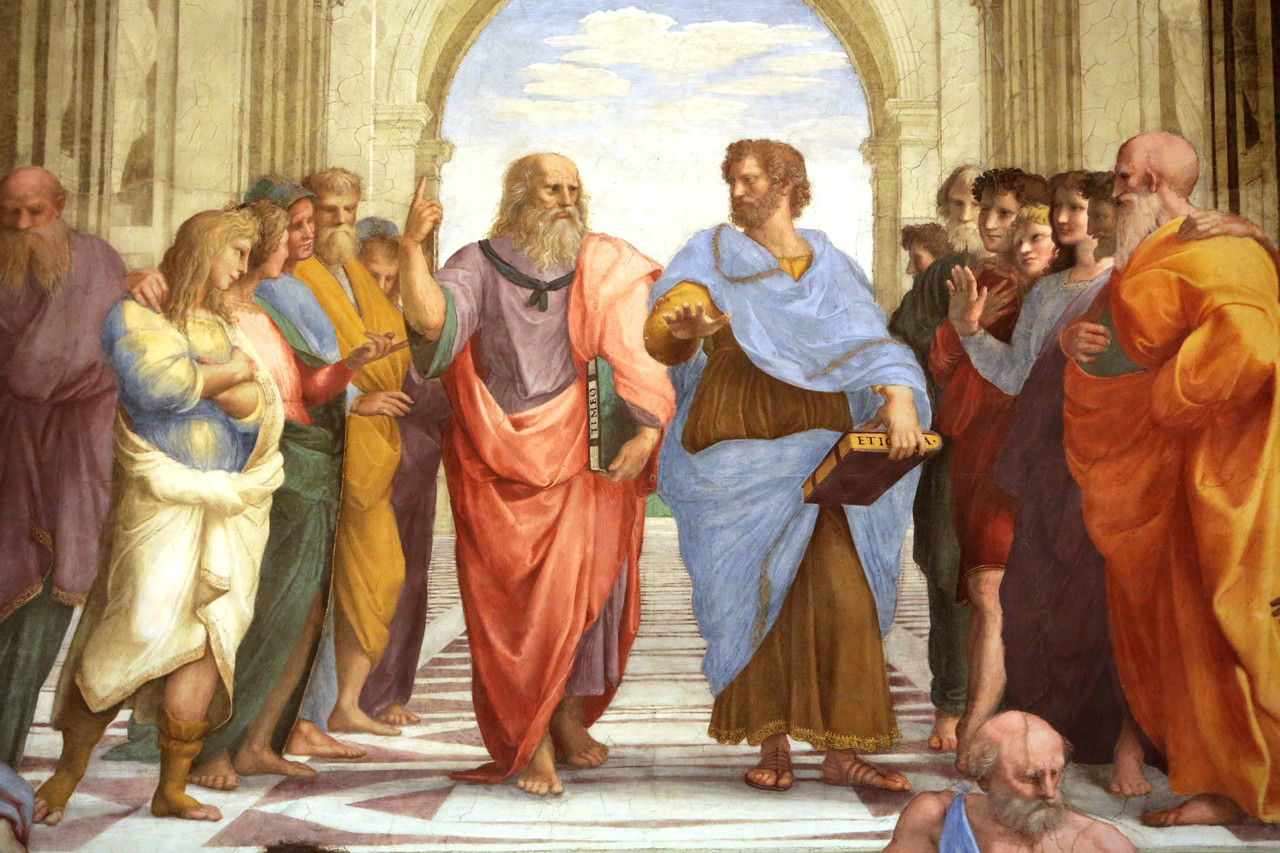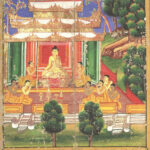Pythagoras: The Father of Greek Philosophy
Pythagoras, Thales of Miletus, Parmenides, Heraclitus, Xenophanes, Parmenides, Zeno, Empedocles, Anaxagoras, Leucippus, and Democritus all made contributions to Pre-Socratic philosophical thought and were referenced by later philosophers and historians to some extent or another.
Although none of the complete works of Pre-Socratic philosophers survive today in full, we do have excerpts and references to their work that allude to who these philosophers were and to some extent what their metaphysical, theological, and philosophical premises and theses were. References to these Pre-Socratic philosophers, quotations as well as summaries of their belief system and philosophies comes from of course Aristotle and Plato, the Middle Platonist Plutarch, the (Epicurean) philosophical historian Diogenes Laertius, from early Judeo-Christian scholars such Philo Judaeus, Origen and Clement of Alexandria and from 3rd and 4th century CE Neo-Platonist authors such as Iamblichus, Porphyry and Simplicius.
It is clear from the works of Plato and Aristotle that they were influenced by these Pre-Socratic philosophers; even if only within the context of disagreeing with their fundamental tenets or conclusions, or illustrating the supremacy of their intellectual premises or beliefs with their predecessors, all of which generally fall under the category of Pre-Socratics. This can be seen for example in that many of the Pre-Socratic philosophers were characters and/or referenced in Plato’s dialogues – Pythagoras and Parmenides for example. All of these Pre-Socratic philosophers, and Socrates himself if we are to believe the portrayal of him by Plato, shared the common principle of the rejection of the hitherto traditional mythological and Theogonical, i.e. divine, explanation of universal creation and order reality that permeated ancient thought, and to a great extent all of them attempted to answer such fundamental questions of the origin of the universe and the nature of reality in a more rational, reasonable fashion as contrasted by the traditions that came before them.
Of the Pre-Socratic philosophers, Pythagoras (c. 570 – c. 495 BCE) is undoubtedly the most influential and the most enigmatic. He is the first supposedly to have called himself a “philosopher”, literally “lover of wisdom”, and as such it is probably not too much of a stretch to call him the father of western philosophy, although many might argue against this depiction. Much of the modern academic literature surrounding Pythagoras, and the tradition which followed him as understood through his disciples, the sect that he founded, and his intellectual influence not only on other Pre-Socratic philosophers, but in the “Italian” philosophical tradition as it was defined in antiquity and looked upon as distinct from the “Ionian” philosophical tradition – as distinguished by Aristotle and Diogenes Laertius among other ancient authors – but also on the “Socratic” tradition as well as reflected on the works of Plato.[2]
Much of the modern academic literature surrounding Pythagoras focuses on what can truly be said to be “historically accurate” concerning his life and teachings. This is a somewhat tricky problem because a) it is widely held that he authored no works himself, b) it is believed that his teachings were to be kept secret by initiates and c) because the biographies of his life that have survived are from authors that lived and wrote centuries after his death, most notably those of the Epicurean philosophical historian Diogenes Laertius who flourished in the early 3rd century CE, and the Neo-Platonists Porphyry and Iamblichus who are also 3rd and 4th century CE authors, some 9 centuries at least after Pythagoras is supposedly to have lived and taught, circa 6th century BCE (570 – 501 BCE).[3]
By the time these biographies were written however, Pythagoras had evolved into a semi-divine figure of fairly eminent heroic stature so the stories surrounding his life and teachings weave myth and history into a single narrative, making it somewhat difficult to ascertain the “facts” regarding not just his biography but also his specific teachings, their origins, and their true import and influence on the subsequent Hellenic intellectual landscape. Diogenes Laertius in his most influential and lasting work Lives of Eminent Philosophers notably spends as much ink on the life and teachings of Pythagoras as he does on Plato and Aristotle, so if nothing else that should give the reader a good estimation on the relative import of this figure on the development of Hellenic philosophical tradition, at least as seen through the eyes of one of the most prominent Philosophical historians in Hellenic antiquity, a work which undoubtedly influenced our understanding of the early development of the Hellenic philosophical tradition as much if not more than any other work in the history of Western intellectual development. It should come as no surprise then that Pythagoras was and is still widely regarded as one of the most influential Hellenic philosophers in antiquity, and certainly is one of the most, if not the most, influential and widely studied of all of the Pre-Socratic philosophers.
Pythagoras was reportedly born on the island of Samos just off the coast of modern day Turkey in the Aegean Sea. This region of the Mediterranean at that time rested just on the Eastern Ionian border, and just on the Eastern borders of what was then the Persian (Achaemenid) Empire. To this extent, and this is true of the cities of Miletus and Ephesus as well, both of which were centers of intellectual thought in the 6th and 5th centuries BCE during the time of the “Pre-Socratic” philosophical movement if we may call it such, it is fairly reasonable to assume some sort of Near Eastern, i.e. Persian and Chaldean, as well as Egyptian influence on the philosophy of Pythagoras.[4]
While Aristotle supposedly wrote a treatise On the Pythagoreans, it is unfortunately no longer extant, so that leaves us with scant relatively contemporaneous sources to look to regarding what can be determined to be “historically accurate” regarding the life and teachings of this famous historical figure from antiquity. Both Herodotus (c. 484 – 425 BCE) as well as Plato (428 – 348 BCE) mention his “school” in passing, and Aristotle (367 – 347 BCE) does refer to a “Pythagorean School” or set of beliefs to which he was associated at somewhat greater length (more on this below), but even these authors write at least a century or two after Pythagoras died so we need to view their assertions and statements regarding what has come to be known as “Pythagorean” philosophy with a certain level of skepticism.[5]
However, what we can surmise definitively from the very early sources was that as an historical figure he did in fact exist, and that he was in fact the founder of a somewhat countercultural intellectual movement (again today what we would call a “sect” which involved some sort of secret initiations and various rights, beliefs and practices), and that he did consider himself to be a philosopher in the later Hellenic sense of the term, that he studied and travelled abroad throughout the Mediterranean and Near East prior to founding his “school” in southern Italy and that at the very least he was well known in antiquity, leaving the question of influence and how well respected he was within the later Hellenic philosophical community (if we may call it that) aside as evidenced for example by the criticism of Pythagoras in a quotation attributed to Heraclitus[6].
So it’s hard to discern fact from fiction as it were with respect to what Pythagoras actually taught versus what the subsequent philosophers that were influenced by him, his students, actually understood and interpreted his philosophy to be. Especially when you’re dealing with a figure that clearly cultivated a semi-divine status and had a religious following of sorts that lasted some several hundred years after his death. What is known is for certain is that he cultivated and promoted a way of life that was vegan, was a believer in the notion of metempsychosis – i.e. that the Soul lives on after death and passes into the bodies of other animate “things” such as plants or animals or even humans or deities depending upon its actions – and that his philosophical teachings were focused on numeric harmony and proportion, from which his association with the famed Pythagorean theory stems from even though he was not a mathematician per se.
All of the historical sources however are fairly consistent when speaking to the various “Oriental” influences on Pythagoras from a theo-philosophical perspective. It is widely held for example that he travelled and studied with various priests and mystics throughout the Mediterranean during his life. In particular it believed that he spent a good deal of time in Egypt, and is also believed to have been influenced and/or initiated by Chaldean and Persian (Magi) priests. It is also believed by some later authors that he was exposed to the philosophy of the Hebrews as well which would not be altogether surprising given the geography and time period within which he lived and taught. Evidence for influence from as far East as India is lacking however, despite many efforts to prove otherwise and despite the fact that his beliefs in reincarnation (metempsychosis) have a very “Eastern” and classically Indian (Hindu) theo-philosophical flavor. Regardless however, Pythagoras for a variety of political and social reasons ended up after his studies and travels settling in Croton in Southern Italy where the bulk of his teachings and followers ensued, and where he eventually met his untimely death around 490 BCE, later being attributed as one of the founders of the so-called “Italian” philosophical school, at least as how Diogenes Laertius distinguished it specifically from the Ionian school as reflected by the teachings of Socrates and his followers to the East (the East of Italy at least).
It was in Persia to the East of Ionia during the time of Pythagoras and the Pre-Socratics that the Magi (the Greek designation for their priestly class during the Median, Achaemenid, Parthian and Sassanian periods of Iranian/Persian history) held such great influence over theological matters as well as presumably matters of state as well which was so often the case in antiquity. These priests, again Magi, were often referred to in the Greek literature in classical antiquity, had a reputation for divination (telling the future) and astronomy, and were in fact the very same class of priests who were said to have come and witnessed the birth of Christ. There is even a tale told by Diogenes Laertius in his Lives of Eminent Philosophers of a letter sent by Darius I, one of the rulers of the Achaemenid Empire, to Heraclitus asking him to join his court as a Greek emissary of sorts, an offer in which he declined apparently.[7]
While at times the Persians were the great adversaries of the Greeks in antiquity, as were at other times the Spartans and the Macedonians each who had their turns at imperial dominion of what later became the Roman Empire, this was the same civilization that had assimilated (really conquered) the Assyrian/Sumer-Babylonian peoples and the same people that adopted in one form or another what came to be known in Greek circles as Zoroastrianism. Zoroastrianism in this context was the form of the worship of great god Ahura Mazda, as understood from the teachings of the legendary Persian prophet Zarathustra, teachings that were captured in the Avesta which held theological influence over the Persians/Iranians from at least the time of the Achaemenid Empire (c. 550 – 330 BCE) down to the time of the Sassanian Empire (224 – 651 CE), up until the overthrow of the Persian (Sassanian) Empire during the first half of the 6th century CE era when they were conquered by the Arabs/Muslims – so for almost 1000 years give or take.[8]
The earliest attested writings attributed to Pythagoras himself are the so-called Golden Verses, a set of aphorisms written in dactylic hexameter verse that are attested to have existed and been in wide circulation as early as the third century BCE, but only show up in the written records by Neo-Platonist authors and commentators in the 5th centuries CE. The aphorisms themselves bear a striking resemblance to a Zoroastrian tradition called andarz[9], which follows a very similar mode of style as the Golden Verses where short sayings or proverbs are attributed to great rulers or teachers that facilitate the cultivation of religious or spiritual endeavors, providing further evidence of the connection between Pythagorean doctrine and Persian theology, i.e. the Magi.[10]
It is also widely held that much of Pythagoras’s numerological and arithmological philosophy, the philosophy of harmony and proportion for which he was so well known, was derived from the Egyptians and/or the Chaldeans. For both the Chaldeans, which heralded from ancient Sumer and Babylon (aka Assyrian) as well as the Egyptians and Indo-Aryans in fact, had a long standing tradition and association with astronomy, mathematics, and geometry, as well as a longstanding belief in the mystical and divine nature of number, arithmology and geometry in general – ideas which played an integral part in what we have come to understand as Pythagorean philosophy.[11]
The earliest reliable reference we have regarding “Pythagorean” philosophy is of course from Aristotle, in particular from Book I of Metaphysics where in typical Aristotelian fashion he outlines (and typically criticizes) previous philosophical belief systems and teachings prior to establishing his own system.
At the same time, however, and even earlier the so-called Pythagoreans applied themselves to mathematics, and were the first to develop this science; and through studying it they came to believe that its principles are the principles of everything. And since numbers are by nature first among these principles, and they fancied that they could detect in numbers, to a greater extent than in fire and earth and water, many analogues of what is and comes into being—such and such a property of number being justice, and such and such soul or mind, another opportunity, and similarly, more or less, with all the rest—and since they saw further that the properties and ratios of the musical scales are based on numbers, and since it seemed clear that all other things have their whole nature modelled upon numbers, and that numbers are the ultimate things in the whole physical universe, they assumed the elements of numbers to be the elements of everything, and the whole universe to be a proportion or number.
…
Well, it is obvious that these thinkers too consider number to be a first principle, both as the material of things and as constituting their properties and states. The elements of number, according to them, are the Even and the Odd. Of these the former is limited and the latter unlimited; Unity consists of both (since it is both odd and even); number is derived from Unity; and numbers, as we have said, compose the whole sensible universe. Others of this same school hold that there are ten principles, which they enunciate in a series of corresponding pairs: (1.) Limit and the Unlimited; (2.) Odd and Even; (3.) Unity and Plurality; (4.) Right and Left; (5.) Male and Female; (6.) Rest and Motion; (7.) Straight and Crooked; (8.) Light and Darkness; (9.) Good and Evil; (10.) Square and Oblong.[12]
Here we see many of the classical elements of Pythagorean philosophy laid out, albeit in a manner that is not altogether clear whether or not the belief systems were held and taught by Pythagoras himself, or were espoused by later interpreters and/or followers of his teachings. Regardless, these doctrines as Aristotle describes them come to be known as the fundamental attributes of Pythagorean philosophy as well as the founding principles upon which the “Italian” school, which Pythagoras is the founding member of, is based.
We have first and foremost the discipline of mathematics assigned to this school of thought, and through which they came to understand that mathematics – number and arithmetic and basic geometry – was basically the language of the universe, or the language through which the universal order, and moral and ethical order of the individual and society at large, could be best understood. The far reaching implications of this belief in the relationship between number, mathematics, geometry and the universal order on Western intellectual developments cannot be overstated. Furthermore, through this “mathematical” understanding of the cosmos, and in particular through their understanding of harmonic and music theory to which Pythagoras himself is closely associated, the Pythagoreans came to believe that harmony and proportionality, which in turn were based upon the relationships of the fundamental numbers between 1 and 10, could be used to describe the universe in its entirety – at least metaphysically and metaphorically speaking.
Furthermore, and this is perhaps where we start to shift more into Aristotle’s interpretation of Pythagorean philosophy rather than perhaps his teachings, or the teachings of his followers, is the leap between the universal harmonic order based upon numbers and their inherent (mathematical and geometrical) relationships, to numbers as “first principles”, which for the most part is what Aristotle is trying to establish in the context of the work which he is speaking about Pythagorean philosophy, i.e. Metaphysics or “first philosophy”. In this context then, Aristotle lists the ten list of fundamental, opposing forces – Even and Odd, Darkness and Light, Good and Bad, Male and Female, etc. – each of which is ascribed a numerical value, and the sum total of which describe all of the elemental forces of the universe –i.e. again his “first principles”.
So we can see here, at least at some level, through the great analytical lens of Aristotle himself, the association of “Pythagorean” philosophy not only with numerology and harmony which is what it has classically come to be seen as predominantly focused on as universal and ontological “first principles”, or arche, but also – and somewhat less emphasized, or in fact altogether ignored, by later interpreters and expositioners of Pythagorean philosophy, is the belief in the universe or cosmos as an ordered structure of pairs of opposites, from which the underlying harmony and balance, i.e. proportion, of the cosmic world order can best be understood, or said another way how the underlying structure of the universe as we “experience” it can best be explained.
The description of Pythagorean doctrinal development by the Syrian Neo-Platonist Iamblichus is also worth mentioning as it is not only more consistent with more modern interpretations of Pythagorean intellectual developments, but it also explains to a certain extent why Aristotle refers to Pythagorean philosophy in the aggregate and avoids attributing the belief systems which have come to be understood as “Pythagorean”, even by the 4th century BCE, to Pythagoras himself. That is to say why Aristotle uses the language the words “so-called Pythagoreans” which is quite different than how he refers to the belief systems surrounding first principles of Empedocles, Anaxagoras, Leucippus, Democritus, Xenophanes and Parmenides from the very same passage which are all described within the very same passage.[13]
In his work Life of Pythagoras, Iamblichus distinguishes between two different branches of Pythagorean thought – akousmatikoi and mathematikoi.[14] The former was in all likelihood the topic of analysis and discussion of the now lost works of Aristotle On the Pythagoreans, as well as the somewhat more contemporary (contemporary to Pythagoras) work by Anaximander of Miletus (c. 610 – 546 BCE) entitled An Explanation of Pythagorean Symbola. These works presumably described and analyzed not just the life of the famed figure Pythagoras himself but also presumably the sayings and aphorisms, i.e. symbola, which had been directly attributed to Pythagoras himself and which encapsulated his philosophical teachings.
These sayings or aphorisms, which dealt primarily with ethical and moral matters, as well as matters of theology and what later came to be known as “philosophy” (with respect to doctrines describing a way of life for example) in all likelihood were the original source of the later compilation of the Golden Verses which again we know circulated throughout the Hellenic intellectual community by at least the 3rd century BCE and which was attributed to Pythagoras himself. The followers of these symbola were, at least in later Neo-Platonic intellectual circles, distinguished from the Pythagorean mathematikoi as akousmata, which according to Iamblichus at least had a musical element, a chanting aspect to them – hence the term. The other branch of Pythagorean thought, i.e. the mathematikoi, were in all likelihood the ones that had the most influence over Platonic philosophy, in particular the underlying geometry of universal order as described in the Timaeus.[15]
What is also interesting and somewhat baffling is that Ovid’s recollection and reverence for Pythagoras is almost entirely left out of the academic literature in terms of it actually truly reflecting “Pythagorean” philosophy, even though a) he explicitly outlines what he means by Pythagorean doctrine, and b) he sits some two centuries at least before the later Neo-Platonist authors of Porphyry and Iamblichus that are typically cited as the most reliable sources for Pythagorean life and teachings, and c) Ovid himself is known to have been well schooled in philosophy and was born and raised in the very same region (Southern Italy) where we know Pythagoras spent a great deal of his later life teaching and where he clearly exerted great influence.
Ovid spends a good deal of his final Book of Metamorphoses covering Pythagorean teachings in fact, told within the context of the story of the founding of Crotone by Numa Pompilius (753-673 BCE), Rome’s legendary second king. Crotone is where Pythagoras founded his “school” and herein Ovid takes the opportunity to run through Pythagorean doctrine as it were, as he describes the founding of the city by Numa and just before he closes his work with the deification of Julius Caesar and Caesar Augustus. After describing the vegan lifestyle, and the belief in the transmigration of souls (metempsychosis), both attributes of Pythagorean thought and doctrine that were and are widely held to be true, Ovid goes on to describe Pythagorean doctrine in more detail, aligning it squarely with his overarching theme for his work in fact, i.e. change or metamorphosis as the primary characteristic and qualification of existence.
‘Since I have embarked on the wide ocean, and given full sails to the wind, I say there is nothing in the whole universe that persists. Everything flows, and is formed as a fleeting image. Time itself, also, glides, in its continual motion, no differently than a river. For neither the river, nor the swift hour can stop: but as wave impels wave, and as the prior wave is chased by the coming wave, and chases the one before, so time flees equally, and, equally, follows, and is always new. For what was before is left behind: and what was not comes to be: and each moment is renewed.[16]
This is not typically the philosophical teaching that is attributed to Pythagoras, Pythagoras the mystical mathematician who espoused the belief in the underlying harmony of number and ratio as reflections of the divine universal order, and although Ovid clearly has an axe to grind to try and closely align one of the greatest Italian philosophers of antiquity with the overarching theme of change which permeates his work, the philosophy that he lays out however is very reminiscent of the philosophy and metaphysics that underlie the cornerstone of Far Eastern (Chinese) philosophy, i.e. the Yijing.
Ovid goes on to describe how the elements themselves are subject to change – earth, air, water and fire – describing a process of transformation that bears even more striking similarity to Yijing metaphysics as its described in the Ten Wings and the various bagua (trigram) arrangements.
‘Even the things we call elements do not persist. Apply your concentration, and I will teach the changes, they pass through. The everlasting universe contains four generative states of matter. Of these, two, earth and water, are heavy, and sink lower, under their own weight. The other two lack heaviness, and, if not held down, they seek height: that is air, and fire, purer than air. Though they are distinct in space, nevertheless they are all derived from one another, and resolve into one another. Earth, melting, is dilated to clear water: the moisture, rarified, changes to wind and air: then air, losing further weight, in the highest regions shines out as fire, the most rarified of all. Then they return, in reverse, revealing the same series of changes. Since fire, condenses, turns into denser air, and this to water, and water, contracted, solidifies as earth.
‘Nothing keeps its own form, and Nature, the renewer of things, refreshes one shape from another. Believe me, nothing dies in the universe as a whole, but it varies and changes its aspect, and what we call ‘being born’ is a beginning to be, of something other, than what was before, and ‘dying’ is, likewise, ending a former state. Though, ‘that’ perhaps is transferred here, and ‘this’, there, the total sum is constant.[17]
So while relatively contemporary interpretations of Pythagorean doctrine most certainly include a references to a certain lifestyle and diet, as well as initiation into a private sect that clearly represented some sort of religious and/or mystery cult type of movement, as well as an association with sacred mathematical and geometric symbolism and a universal order based upon the interaction of a finite set of opposing, basic elemental forces, we also find with Ovid in particular an association of Pythagorean teachings with basic elemental change, as well as an integration and assimilation of the teachings in general to the more archaic and pre-historic Mythos of the Hellenic world to which Ovid’s entire work rests in in fact.
What we find in Ovid’s interpretation of Pythagorean teaching, is a more archaic form of theology as it were, and one that is hinged on the idea of change and flux being the primordial characteristic of existence, as well as – consistent with Aristotle’s interpretation of Pythagorean philosophy in terms of first principles – the idea or notion that the universe is best understood as the interrelationships and intermixing of a basic set of opposing forces, forces which are aligned with number, proportion and harmonic balance. In total, in looking at the “philosophical” interpretation of Pythagorean theology and cosmology, and combining it within the mythological and more pre-historic narrative provided by Ovid and his notion of change as being the primordial elemental property of reality, we are left with a worldview, a theo-philosophical system, that looks very similar to that which is represented by the Classic of Changes, i.e. the Yijing, from the Far East, a view and a comparison which is rarely made – if ever – and one which begs the question as to where and why these similarities exist between two of the primordial philosophical systems that emerge from these geographically disparate and theoretically distinctive civilizations which we believe did not have any sort of cultural or social connection at this phase in their respective civilizational development.
[2] According to Aristotle, Platonic philosophy is for the most part “aligned” with and consistent with the “Italian” schools which came before him. of which Pythagoras is the most eminent and influential figure of course. He also aligns Platonic philosophy with Heraclitus as well, specifically in reference to his doctrine of the whole sensible world being in a state of “flux”. See Aristotle. Metaphysics. Book I .987a from Aristotle. Aristotle in 23 Volumes, Vols.17, 18, translated by Hugh Tredennick. Cambridge, MA, Harvard University Press; London, William Heinemann Ltd. 1933, 1989.at http://www.perseus.tufts.edu/hopper/text?doc=Perseus%3Atext%3A1999.01.0052%3Abook%3D1%3Asection%3D987a
[3] While references to Pythagoras can be found in the extant works of both Plato and Aristotle, it can be argued that neither of them assign him specifically with the establishment philosophical significance per se. See Huffman, Carl, “Pythagoras”, The Stanford Encyclopedia of Philosophy (Summer 2014 Edition), Edward N. Zalta (ed.), URL = <http://plato.stanford.edu/archives/sum2014/entries/pythagoras/>.
[4] Miletus was the epicenter of the so-called Milesian School where Thales, Anaximander and Anaximenes, all very prominent early Pre-Socratic philosophers heralded from, and Ephesus was the home of Heraclitus, the famed philosopher of flux and change which supposedly, according to Aristotle at least, heavily influenced the philosophic thought of Plato.
[5] Herodotus says that the Pythagoreans agreed with the Egyptians in not allowing the dead to be buried in wool in his Histories Book II, verse 81. See The History of Herodotus, parallel English/Greek, tr. G. C. Macaulay, [1890], at sacred-texts.com at http://www.sacred-texts.com/cla/hh/hh2080.htm. For the reference to the Pythagoreans in Plato’s Republic where Plato associates the Pythagoreans with a doctrine of universal harmony with respect to astronomical matters, see Republic 7.530d from Plato in Twelve Volumes, Vols. 5 & 6 translated by Paul Shorey. Cambridge, MA, Harvard University Press; London, William Heinemann Ltd. 1969 at http://www.perseus.tufts.edu/hopper/text?doc=Perseus%3Atext%3A1999.01.0168%3Abook%3D7%3Asection%3D530d.
[6] “Much learning does not teach one to have understanding, else it would have taught Hesiod and Pythagoras, and again Xenophanes and Hecataeus.” Quotation attributed to Heraclitus by Diogenes Laertius, Proclus and other ancient authors. See Heraclitus of Ephesus, translated by G.W.T. Patrick 1889 at http://classicpersuasion.org/pw/heraclitus/herpate.htm.
[7] Lives of Eminent Philosophers. Diogenes Laertius. R.D. Hicks. Cambridge. Harvard University Press. 1972 (First published 1925). Book IX, Chapter I. Verses 12-14. See http://www.perseus.tufts.edu/hopper/text?doc=Perseus%3Atext%3A1999.01.0258%3Abook%3D9%3Achapter%3D1.
[8] Affinities and similarities between the culture and theological beliefs in the Avesta literature and the Vedas of the Indo-Aryans is covered in detail in other sections of this work.
[9] See http://www.iranicaonline.org/articles/andarz-precept-instruction-advice.
[10] For the full listing of 71 aphorisms, see Wikipedia contributors, ‘The golden verses of Pythagoras’, Wikipedia, The Free Encyclopedia, 23 February 2016, 20:59 UTC, <https://en.wikipedia.org/w/index.php?title=The_golden_verses_of_Pythagoras&oldid=706531167> [accessed 28 September 2016]
[11] The opening passage to the famed Egyptian Rhind Mathematical Papyrus for example, a mathematical textbook which dates to the early part of the second millennium BCE more than 1000 years before Pythagoras was born, reads: “Accurate reckoning. The entrance into the knowledge of all existing things and all obscure secrets.”. From the Rhind Mathematical Papyrus. Volume I. Free Translation and Commentary by Arnold Buffum Chace. Mathematical Association of America, Oberlin, Ohio. 1927. Page 49. The actual papyrus dates to around 1650 BCE and we are told is from a copy from an even older text dating from the 19th century BCE during the reign of Amenemhat II. It was written in hieratic script and is a mathematical textbook of sorts which contains teachings and formulas on not just basic arithmetic and geometry, but also calculation of volume and area, fairly sophisticated algebraic equations and solutions, and other advanced geometry and mathematical topics that was clearly produced as a teaching tool. The Indo-Aryans as well, at least with respect to geometry and basic mathematics and algebra as reflected in the Shulba Sutras, a text related to the construction of altars related to Agni (fire) worship and altar construction dated from the early part of the first millennium BCE. For a deeper exploration of the connections between ancient Greek and Vedic geometry see “Greek and Vedic Geometry” by Frits Staal. Published in the Journal of Indian Philosophy in 1999 by Kluwer Academic Publishers. Vol. 27, No. 1/2, pg. 105.
[12] Aristotle. Metaphysics Book I 985b 986b. Aristotle. Aristotle in 23 Volumes, Vols.17, 18, translated by Hugh Tredennick. Cambridge, MA, Harvard University Press; London, William Heinemann Ltd. 1933, 1989. From http://www.perseus.tufts.edu/hopper/text?doc=Perseus%3Atext%3A1999.01.0052%3Abook%3D1%3Asection%3D985b
[13] Again see Aristotle Metaphysics 1.985a – 1.986b. Aristotle. Aristotle in 23 Volumes, Vols.17, 18, translated by Hugh Tredennick. Cambridge, MA, Harvard University Press; London, William Heinemann Ltd. 1933, 1989. From http://www.perseus.tufts.edu/hopper/text?doc=Perseus%3Atext%3A1999.01.0052%3Abook%3D1%3Asection%3D985a
[14] The Life of Pythagoras by Iamblichus. Translated from the Greek by Thomas Taylor. Theosophical Publishing House, Hollywood, CA. 1918. Page 62-64.
[15] For a detailed treatment of the source and nature of these “akousmata”, as well as a description of the delineation between “akousmatikoi” and “mathematikoi” as described by the Neo-Platonist Iamblichus, see “The Pythagorean Akousmata and Early Pythagoreanism” by Johan C. Thom at https://www.academia.edu/15440495/The_Pythagorean_Akousmata_and_Early_Pythagoreanism
[16] Ovid’s Metamorphoses, translated by Anthony S. Kline, 2000. Bk XV:176-198. “Pythagoras’s Teachings: The Eternal Flux.” From http://ovid.lib.virginia.edu/trans/Metamorph15.htm.
[17] Ovid’s Metamorphoses, translated by Anthony S. Kline, 2000. Bk XV:237-258. “Pythagoras’s Teachings: The Elements” From http://ovid.lib.virginia.edu/trans/Metamorph15.htm.









Leave a Reply
Want to join the discussion?Feel free to contribute!